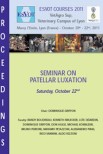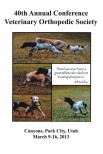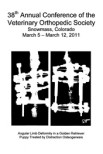A four-month-old intact male Bernese Mountain Dog was presented for an orthopedic examination due to an abnormal hind limb gait and tarsal hyperextension for the past 2 weeks.
Pain was observed upon palpation of the lumbosacral region. Moderate bilateral tarsal hyperextension and mild metatarsal outward rotation were observed. A wide, slightly abducted stance and a stiff gait were noted in the hind limbs. Radiographs revealed symmetric erosive lesions in the left sacroiliac joint (SIJ) and laxity of the hip joints. Computed tomography (CT) revealed multiple deep articular bone erosions with peripheral sclerosis of both SIJs, accentuating the iliac bones with consequential irregular widening of the sacroiliac joint spaces.
The dog was treated conservatively with carprofen, physiotherapy, joint nutraceuticals, and exercise restriction. Complete resolution of clinical signs was observed on orthopedic examination within 3 weeks. The dog remained clinically normal, with partial resolution of the radiographic lesions, during a follow-up after 6 weeks. The dog remained in clinical remission, and radiographs and CT imaging revealed complete resolution of the erosive lesions at the 1.5-year follow-up.
Sacroiliac joint pain is a possible rare cause of lower back pain, gait abnormality, and lameness in dogs. Case reports of both septic erosive and non-erosive, non-septic SIJ arthropathy have been described. However, a diagnosis of sterile erosive SIJ arthropathy is presumed in this case, since the clinical recovery was uneventful with carprofen and physiotherapy.









